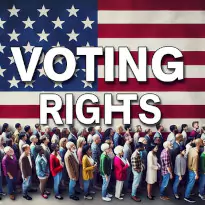How to Identify and Combat Voter Suppression
Gerrymandering, a term that sounds almost whimsical, has great and often controversial implications in the world of politics. Voter Suppression refers to the manipulation of electoral district boundaries to favor one party or class.
Key Takeaways
- Recognizing Tactics: Awareness of voter suppression tactics helps individuals identify and combat these practices.
- Protecting Democracy: Ensuring fair voting processes upholds democratic values and equality.
- Advocacy and Education: Active participation in promoting voter rights and educating others is essential to combating voter suppression.
Table of Contents
- Understanding Gerrymandering or Redistricting
- Gerrymandering Origins:
- Gerrymandering -Not Just an American Issue:
- Modern Solutions for Gerrymandering in the United States:
- Election-related litigation to Gerrymandering
- Why Voter Suppression Matters
- How To Understand Gerrymandering And Why It’s Important
- Frequently Asked Questions
Understanding Gerrymandering or Redistricting

Voter suppression in the United States refers to various strategies, laws, and practices aimed at preventing eligible voters from exercising their right to vote. Historically rooted in efforts to disenfranchise African American voters, particularly in the South, these tactics have evolved.
Modern forms of voter suppression include strict voter ID laws, purging voter rolls, limiting early voting, reducing the number of polling places in certain areas, and gerrymandering districts to dilute the voting power of specific groups. These practices disproportionately affect minority communities, the elderly, and lower-income voters.
The debate around voter suppression is highly polarized, with one side arguing for tighter measures to prevent voter fraud, and the other advocating for greater accessibility to ensure every eligible citizen can participate in the democratic process.
Gerrymandering Origins:
The term ‘gerrymandering’ comes from a blending of ‘salamander’ and ‘Elbridge Gerry’, an early 19th-century governor of Massachusetts. On February 11, 1812, Elbridge Gerry, the governor of Massachusetts, initiated the first-ever “gerrymander”. By signing a controversial redistricting plan into law.

This plan aimed to secure his political party’s dominance in the upcoming election. Motivated by opposition to the Federalist Party’s criticism of James Madison’s foreign policy. Gerry approved a reallocation scheme that significantly favored his Republican party.
Despite his reputation for strongly sticking to his principles, often against his colleagues’ popular actions. Gerry hesitated before signing the bill. Nevertheless, he ultimately endorsed the Republican legislators’ strategy. Which involved redrawing voting lines to dilute the Federalist vote across a few districts. While spreading the Republican vote over many districts.
This strategic redistricting resulted in a sweeping victory for Gerry’s Republicans. Who secured 29 seats compared to the Federalists’ meager 11. Notably, Gerry’s own Essex district featured a peculiarly elongated and curved shape along its northern end. Thought to resemble a salamander.
Two primary ways Gerrymandering is used in redistricting:
Packing:
This involves concentrating many voters of one political party into a single electoral district, thus reducing their influence in other districts.
Cracking:
This means dispersing voters of a particular political party among multiple electoral districts, diluting their power in each of them.
What are the effects of gerrymandering on Democracy:
Unequal Representation:
By its very design, gerrymandering skews representation. It can allow a party with a minority of voters to win a majority of districts and, as a result, gain unequal representation.
Discouraging Competition:
When one political party gains a clear advantage by diluting groups of voters of one political party within voting districts. It can deter potential challengers from running for office, restricting choice for voters.
Erosion of Trust:
As voters become aware of gerrymandering, it can lead to disillusionment and a loss of faith in the democratic process.
Impact on Policies:
Gerrymandered districts can lead to policies that cater to specific groups or interests, ignoring the broader needs and desires of the community.
Gerrymandering –Not Just an American Issue:
The United States, more commonly associated with Gerrymandering or Voter Suppression, it’s not exclusively an American experience. Other countries, with different political structures, also grapple with issues of redistricting and representation. For example, The United Kingdom, India, Hungry and Malaysia.
Australia Takes A Different Approach.
Australia takes a different approach to electoral boundaries and voting in general. Referred to as the Commonwealth Electoral Act of 1918 which gave birth to The Australian Electoral Commission also known as the shorter AEC.
A look at Key Points
- Independent Redistricting: Independent commissions, notably the Australian Electoral Commission (AEC) determine Australia’s electoral boundaries. Importantly, no political party controls the AEC. This independent body helps reduce the risk of partisan gerrymandering,
- Compulsory Voting: This means that every eligible citizen must vote in elections. This system significantly reduces the impact of voter suppression tactics, as the government actively works to ensure that everyone votes.
- Robust Voter Registration: The voter registration system in Australia is proactive and inclusive. The AEC regularly updates electoral rolls and makes considerable efforts to include as many eligible voters as possible, including conducting enrollment drives and providing easy online registration options.
- Regular Redistribution of Electoral Boundaries: The AEC regularly reviews and adjusts electoral boundaries to reflect population changes. This process with public input maintains transparency, reducing the likelihood of politically motivated redistricting.
This system is not perfect and also creates its own set of challenges. In the long run, the system is generally recognized for minimizing the risks of gerrymandering and voter suppression we see in many other countries.
Modern Solutions for Gerrymandering in the United States:
The United States could benefit from adopting certain aspects of Australia’s model. Especially removing the control of voter districts from state legislation to an independent body. Requiring all Legal citizens to register to vote and mandatory voting in all elections.
Independent Redistricting Commissions:
Some states in the U.S. have turned to independent bodies to draw electoral boundaries, aiming for fairness and minimizing political influence.
Technological Aids:
Notwithstanding, the challenges of using algorithms and software as tools to help create more balanced districts.
Legal Challenges:
Law suites over gerrymandered maps end up in the court system and are overturned due to their bias.
New Voting Laws
Notably, dozens of pieces of restrictive legislation passed since 2021 and face legal challenges. Certain provisions of restrictive voting laws passed in Mississippi and Florida were temporarily blocked by federal courts. For example, new voter ID rules in North Carolina face a federal lawsuit. Potentially impacting their use in the 2024 elections depending on the timing of the trial.
Election-related litigation to Gerrymandering
In 2022, Arizona, Pennsylvania, and Wisconsin were the top three states with the most election-related litigation. Arizona had 35 lawsuits, followed by Pennsylvania with 21 and Wisconsin with 16.
Many of these lawsuits aimed to undo restricted voting access, and the legal activity reflects broader litigation strategies by political parties and groups influencing election policy,
It’s essential to recognize that the landscape of election law litigation is dynamic, with new developments likely occurring regularly as the 2024 elections approach. More so, legal challenges to voting laws often focus on issues like voter ID requirements, mail-in voting policies, and the administration of elections, which are pivotal areas in ongoing debates about electoral integrity and access.
States with ongoing legal challenges to Gerrymandered Districts
The states with ongoing legal challenges to voter laws as of the latest information available:
- Arizona
- Florida
- Mississippi
- North Carolina
- Pennsylvania
- Wisconsin
As of July 2023, there were ongoing challenges to congressional and legislative maps in 27 states. Due to allegations of racial discrimination or partisan gerrymandering. These challenges have resulted in redrawn maps in several states, including
- Alaska
- Maryland
- New York
- North Carolina
- Ohio
- South Carolina
Further litigation is expected to lead to redrawn maps in Alabama and Louisiana. There are ongoing litigations specifically over congressional maps in 11 states and legislative maps in 18 states.
Legal Challenges to Gerrymandered Districts Congressional and State Legislative Maps:
| State | Controlling Party | State Legislative | Congressional |
|---|---|---|---|
| Alabama | *Republican | Yes | Yes |
| Alaska | Divided government | Yes | No |
| Arkansas | *Republican | Yes | Yes |
| Florida | *Republican | No | Yes |
| Georgia | *Republican | Yes | Yes |
| Kansas | Divided government | No | Yes |
| Louisiana | Divided government | Yes | Yes |
| Michigan | *Democratic | Yes | No |
| Mississippi | *Republican | Yes | No |
| New Hampshire | *Republican | Yes | No |
| New York | *Democratic | Yes | No |
| Ohio | *Republican | Yes | Yes |
| South Carolina: | *Republican | Yes | Yes |
| Tennessee | *Republican | Yes | No |
| Texas | *Republican | Yes | No |
| Utah: | *Republican | No | Yes |
| Washington | *Democratic | Yes | No |
Poverty Levels of States with Voting Map Lawsuits
| State | Poverty Level | Total Population | % Not Literate 2023 |
|---|---|---|---|
| Mississippi | 19.58% | 2,883,074 | 28 |
| Louisiana | 18.65% | 4,532,187 | 27.1 |
| Arkansas: | 16.08% | 2,923,585 | 23.1 |
| Alabama: | 15.98% | 4,771,614 | 23.9 |
| South Carolina: | 14.68% | 4,950,181 | 22.4 |
| Tennessee: | 14.62% | 6,603,468 | 21.7 |
| Georgia | 14.28% | 10,238,369 | 23.6 |
| Texas: | 14.22% | 28,013,446 | 28.2 |
| Ohio: | 13.62% | 11,350,378 | 17.7 |
| Michigan: | 13.71% | 9,753,541 | 17.6 |
| New York: | 13.58% | 19,009,098 | 24.4 |
| North Carolina: | 13.98% | 10,098,330 | 21.3 |
| Florida | 13.58% | 20,793,628 | 23.7 |
| Kansas: | 11.44% | 2,828,498 | 16.9 |
| Alaska: | 10.34% | 719,445 | 12.7 |
| Washington: | 7.9% | 7,372,433 | 16.1 |
| Utah: | 7.2% | 3,380,800 | 14.5 |
| New Hampshire: | 5.3% | 1,395,231 | 11.5 |
Why Voter Suppression Matters
Voter suppression whether by enacting suppressive voting laws or diluting district maps continues to be a significant and contentious issue within democratic systems. It represents a profound challenge to the principles of fair representation and electoral integrity.
Gerrymandering involves the deliberate manipulation of electoral district boundaries to create an unfair advantage for a particular party or group. This practice undermines the democratic ideal that political power should reflect the will of the people, rather than the strategic interests of those in authority who draw the maps.
To ensure equity and fairness in representation, many advocate for nonbiased or independent redistricting commissions, strict legal standards, and transparent processes. The goal is to prevent the dilution of votes and ensure that each citizen’s vote has equal weight, regardless of geographic or demographic considerations. The ongoing debates and legal battles over redistricting in states across the U.S. highlight the importance of these measures in maintaining the health and integrity of a representative democracy.
How To Understand Gerrymandering And Why It’s Important
Frequently Asked Questions
What is voter suppression?
Voter suppression refers to various strategies used to prevent or discourage certain groups of people from voting, often targeting minorities and marginalized communities.
Why is understanding voter suppression important?
Understanding voter suppression is crucial to recognizing and combating efforts that undermine democratic principles and ensuring fair and equal voting rights for all citizens.
What are common tactics of voter suppression?
Common tactics include strict voter ID laws, purging voter rolls, reducing polling places, and limiting early voting opportunities.
How does voter suppression impact elections?
Voter suppression can skew election results by disproportionately affecting voter turnout among specific groups, often leading to an unrepresentative outcome.
What can individuals do to fight voter suppression?
Individuals can support policies that promote voting rights, participate in voter education campaigns, and advocate for fair voting practices.

There is obviously a bundle to know about this. I consider you made certain nice points in features also.